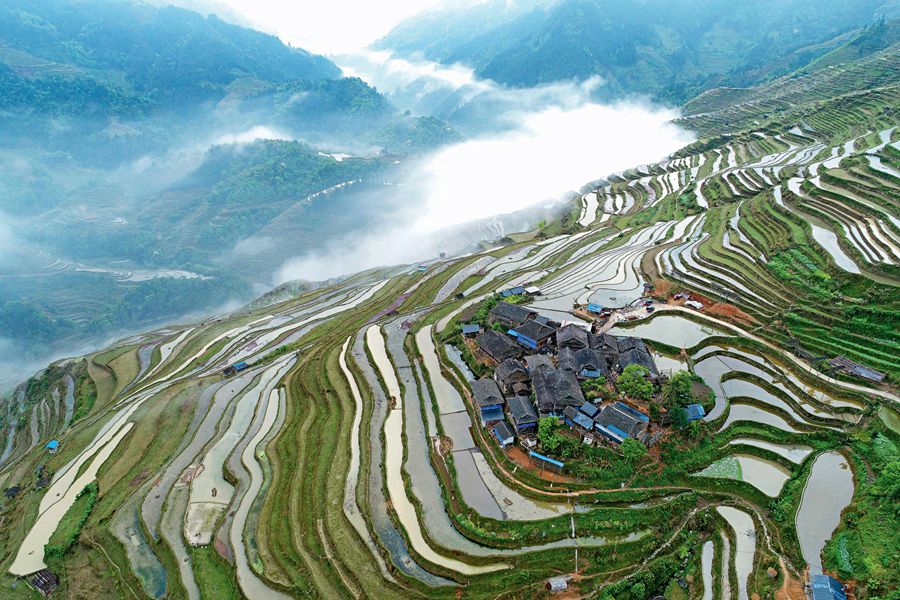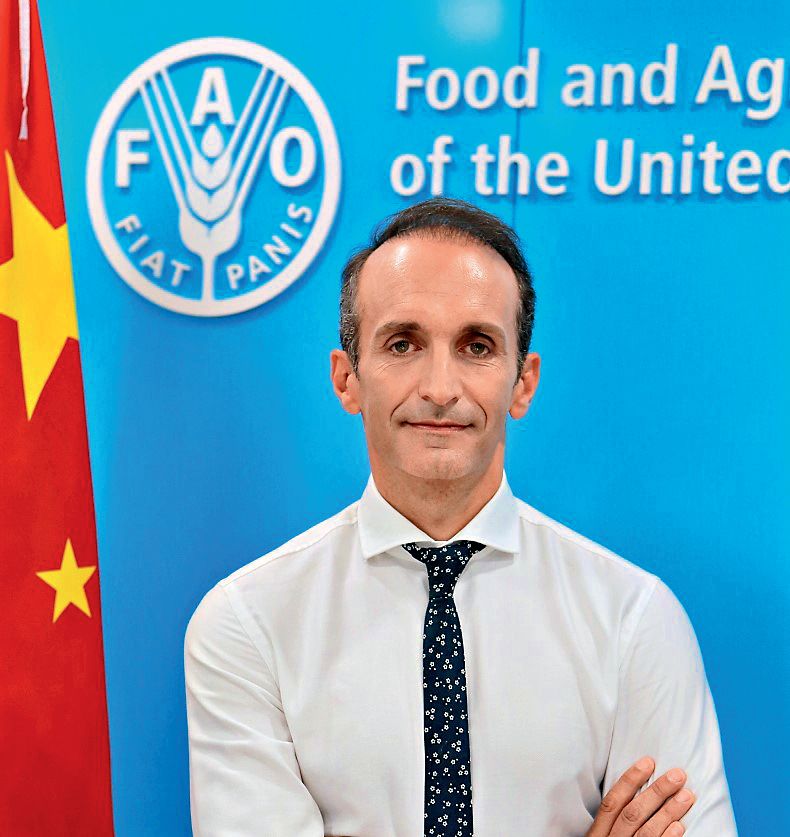OVER the past four decades of reform and opening-up, China’s economic development has accomplished significant achievements, Economic and social growth in poverty-stricken areas, especially, has made great strides. “In just four decades, China lifted about 740 million people out of poverty as a result of comprehensive and innovative approaches that have successfully reached vulnerable populations. The UN Millennium Development Goals (MDGs) aimed at reducing the number of people living in extreme poverty by half. China was the first developing country that has achieved the target ahead of time,” Vincent Martin, the UN Food and Agriculture Organization’s (FAO) representative in China and the Democratic People’s Republic of Korea, remarked in an interview with China Today. China has created a miracle in the history of poverty reduction, making tremendous contributions to the fulfillment of the UN MDGs.

Jiabang Rice Terraces of Guizhou Province are an important global agricultural cultural heritage for the rice-fish-duck symbiosis system of the Food and Agriculture Organization of the United Nations.
Today, as China has evolved from an aid recipient country to a major donor country, the cooperation between the two sides has come to a turning point. “In more recent years, with the changes in the world political and economic situations and the rapid development of China’s agriculture and rural economy, China’s cooperation with FAO has entered into a new stage,” Vincent Martin said.
China will benefit the whole world with its development achievements, providing technical assistance, financial support, and development solutions to developing nations around the globe. China’s poverty reduction has exerted significant international influence, providing a model for poverty reduction initiatives in other countries.
Innovating Poverty Alleviation Approaches
Since the 18th CPC National Congress, more than 60 million impoverished people have been lifted out of poverty, and China has contributed more than 70 percent to global poverty reduction. Its innovative approaches of poverty elimination, in particular, have impressed the whole world.
“China has transformed its agricultural sector through a long-term vision embodied by high investment in agriculture research, structural reforms, and supporting policies. China sets an example in the area of agricultural development, and has accumulated a wealth of experience and techniques that can be shared with the rest of the developing world,” Vincent Martin said.
With the “Internet Plus” era unfolding, China has been leveraging e-commerce to address rural poverty. “FAO, with the government of China, is exploring innovative agricultural models for poverty reduction with the combination of ‘agriculture + e-commerce + finance’ to link farmers with markets,” Vincent Martin remarked. Advanced technologies such as e-commerce, e-finance, unmanned aerial vehicles, big data, and cloud computing have tremendously impacted the development of rural economy, and have become important means for targeted poverty alleviation and rural revitalization. The success in aiding the poor through e-commerce is of great significance to all countries around the globe. China’s e-commerce giants introduced not only financial and industrial assistance, but also a set of new economic concepts and business models, which will ultimately help the rest of the world eradicate poverty and achieve common development.
Under the umbrella of the FAO-Tsinghua AgLab-Cx Innovation Lab, in 2018, FAO and Tsinghua University launched an eight-week postgraduate course using user-centered design thinking methods with the aim of answering challenges in the agricultural and food sector, such as the precariousness of poor smallholder farmers, and their lack of connectivity and access to markets. An incubation event was organized in collaboration with Tsinghua, the China Foundation for Poverty Alleviation, and China Internet Information Center (CIIC), to facilitate youth entrepreneurship for rural development and narrow the connectivity gaps among poor farmers as well as between farmers, decision makers, and markets in China.

Vincent Martin, the UN FAO’s representative in China and the Democratic People’s Republic of Korea.
FAO China office has embarked on an innovation journey, identifying innovation as a key cross-cutting theme for its Country Programming Framework (CPF) 2016-2020. Vincent Martin noted that we have been exploring the use of ICTs (information and communication technologies) tools to insufflate innovation into its Farmer Field School (FFS) flagship program and unlock the potential of rural areas. FFS+ICTs approaches for poverty alleviation will allow knowledge and expertise to reach the most remote farmers, will be tailored to the needs of the poor, and could be of great value to agricultural extension and poverty reduction efforts in China and elsewhere in the world.
Strengthening Regional and Global Food Security
Today’s world is undergoing complex and profound transformations, the global economy is bogged down in sluggish recovery, and the development problems faced by countries worldwide are still severe.
Long Yongtu, former Vice Minister of Foreign Trade and Economic Cooperation, remarked that the Belt and Road Initiative is a proposal full of China’s political wisdom. Many countries along the routes are quite isolated and in dilapidated circumstances. He hopes that the Belt and Road Initiative will become the largest poverty alleviation project around the globe, and can help lift hundreds of millions of people out of poverty.
The Belt and Road Initiative is to transform the experience accumulated by China over the past 40 years into the development advantages of these countries, so that they can benefit from the growth of China. An important goal of the initiative is to bring the countries and people along the routes into globalization and get rid of poverty.
Vincent Martin noted that the Belt and Road Initiative is an ambitious program aiming to achieve economic prosperity of countries along the routes by promoting greater regional economic cooperation and integration. The initiative also explicitly mentions promoting cooperation among BRI countries in the agricultural sector. As a matter of fact, the transportation infrastructure being built under the initiative is creating new opportunities to expand production and trade of agricultural products, hence having the potential to contribute to regional and global food security.
FAO developed in 2018 an umbrella program for supporting agriculture development in Belt and Road countries. The overall aim of the program is to improve food security, support poverty alleviation and sustainable natural resources management, and make full use of investments made to spur rural development under the initiative.
Championing New South-South Cooperation
As a grand initiative for developing countries to unitedly reinforce strength, South-South cooperation is of great significance in the current international context.
At the global strategic level, enhancing cooperation among developing countries contributes to promoting a more balanced global balance of power. With the rise of isolationism and trade protectionism, China’s relations with the world have undergone historic changes. Strengthening South-South cooperation will fuel the momentum of global development and tap the potential of cooperation and growth of developing countries. South-South cooperation has entered a new era, which requires relevant countries to open new fronts, explore new mechanisms, develop new impetus, and achieve new goals. Establishing a community of shared future for developing countries should be the orientation of new South-South cooperation.
Since the new century is ushered in, China has undertaken more historic missions to promote new South-South cooperation. “China has been a front runner to support South-South cooperation in the UN,” said Vincent Martin.
Luan Jianzhang, director of the Research Office of the International Department, CPC Central Committee, and secretary-general of China Council for BRICS Think-tank Cooperation, noted that the content and scope of the new pattern of South-South cooperation have been expanding from traditional economic and trade cooperation to more domains including exchange of ideas, sharing of experience, and mutual support on major international issues. In the new pattern of South-South collaboration, China is producing more governance concepts in addition to powering the economic growth.
With growing influence on the global arena, China is conveying accumulated experience and confidence to other developing nations. It plays a more vital role in leading and promoting new South-South cooperation. China innovates its concept of development, vigorously promotes peace, development and win-win cooperation, and highlights sustainable, fair, comprehensive, and common development.

